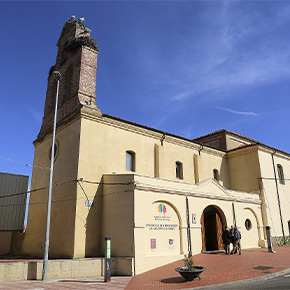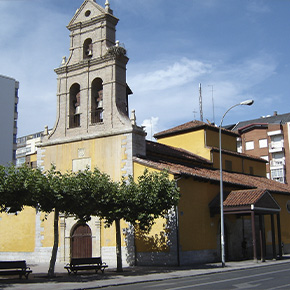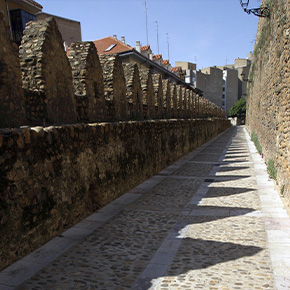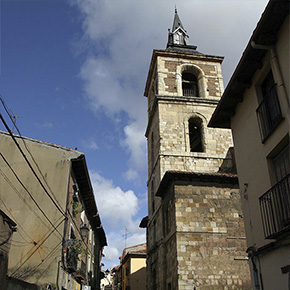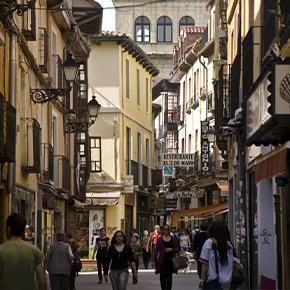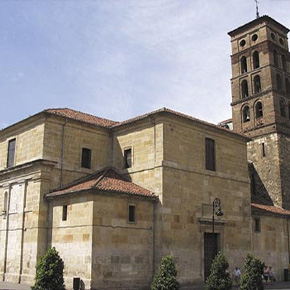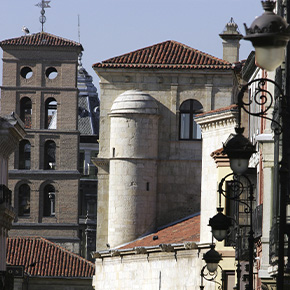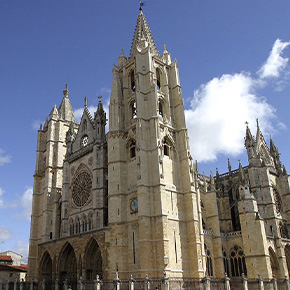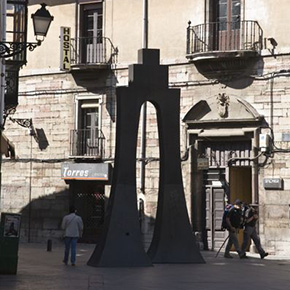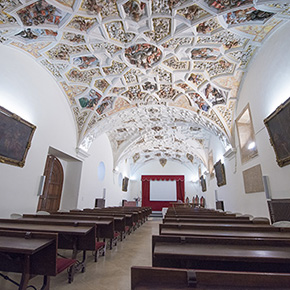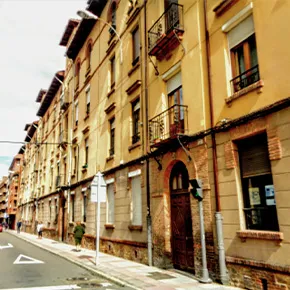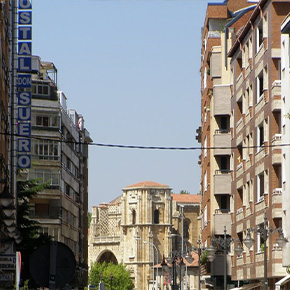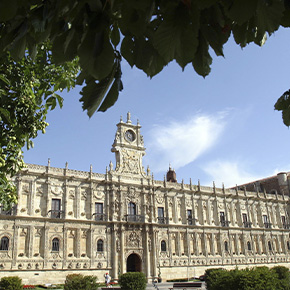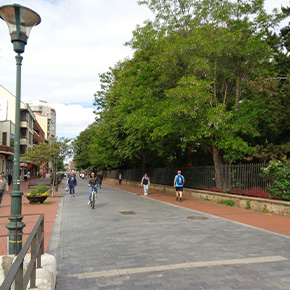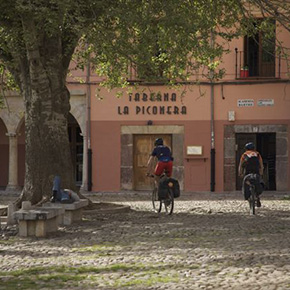CHURCH OF SAN PEDRO, THE ENTRANCE GATE TO LEON
The suburb of Puente Castro, which goes down to the banks of the river Torío, used to be called the Castrum Iudeorum (Settlement of the Jews) as it was once the site of the Jewish ghetto of the city, built on what was once a remote village of the pre-Roman Astur tribe.
As an act of remembrance of the Jewish people. the church of San Pedro is home to the Interpretation Centre of Jewish Leon and of the Way of Saint James, since here is the starting point of the Way
for all the pilgrims who set off with the scallop shell, walking stick and rucksack to reach the city in their journey from east to west in search of knowledge.
SANTA ANA, ANCESTRAL WISDOM
Countless myths and legends have grown around the Way of Saint James, but there are also realities such as the church of Santa Ana, the first church of the city to welcome the pilgrims.
Previously dedicated to the Holy Sepulchre, the church had an ossuary alongside containing the remains of the unfortunate pilgrims who died along the way. The ancestral wisdom of the church transmitted a message of tolerance between Jews, Moors and Christians. Buenaventura Durruti, the famous anarchist leader, was born near the church in 1896.
PUERTA MONEDA, COMMERCE AND CULTURE
The route continues up to Puerta Moneda, a road full of medieval memories whose name refers to the entrance made in what was called the Cerca Nueva during the reign of Alfonso XI.
The area welcomed coin makers who minted coins of copper, silver and gold, besides operating as money changers for pilgrims. This process was a major contribution to the tremendous growth in trade and cultural exchanges brought about by the Way of Saint James as a source of civilisation and progress.
IGLESIA DEL MERCADO (MARKET CHURCH), CELESTIAL APPARITIONS
Regarded as one of the most important stops on the most important pilgrimage in Europe, the church of Nuestra Señora del Camino, popularly known as the church of the Mercado, was witness in 560 CE to a celestial apparition that forms a major part of the collective memory of Leon.
A shepherd caring for his flock found an image of the Virgin Mary in some bushes. This event, called by many “The Apparition”, is now marked by a stone cross, located in the plaza del Grano.
THE RÚA, BETWEEN HEAVEN AND EARTH
The alchemical path of the Milky Way continues towards the Calle de la Rúa, where you can find the Convent of the Concepcionists.
The street, previously called Rúa de los Francos, is one of the streets with most personality in old Leon, along which thousands of sandaled feet have passed in a rhythm marked by wooden staffs. It is often said, and rightly so, that there are many Ways as there are pilgrims, but the Rúa continues to be a direct witness of the human river that flows between heaven and earth towards Santiago.
SAN MARCELO, A WORLD OF DETAILS
The Way of Saint James is a complex web of legends and stories as real as the “confession of faith” of the Roman centurion Marcellus, an officer of the Legio VII, who would then be martyred.
In the same place as where he proclaimed his conversion to Christianity, a church was erected that now holds the saint’s relics in an urn at the high altar. The church is a spiritual reference point within a setting full of historical and architectural details.
CALLE ANCHA, THE SOUNDS OF LIFE
The world in movement created by the pilgrims now enters the Calle Ancha, an artery that has seen all the ideas and goods brought along the Way pass by.
The exuberant sounds of life can be palpably detected in this part of the route, where shops that have been open for over a hundred years, selling the very best goods and products are open to all. A setting that was once home to the carnivals and other local celebrations, the Calle Ancha is, in the words of Cayón Waldaliso, a place that has everything, even the Cathedral at the end of the street.
THE CATHEDRAL, THE STUFF OF DREAMS
The protocol of the Way has always required pilgrims to stop before this masterpiece of Gothic art: the Cathedral of Santa María.
The main entrance built with the stuff of dreams has a statue of the Virgen Blanca or Virgen de las Nieves. There is also the Locus Apellationis, the place where the court that judged and passed sentence for crimes committed in medieval Leon was held. Offenders included locals of the area and outsiders who passed through the city on their way to Santiago.
BARRIO ROMÁNTICO, GOOD TASTE, LEONESE STYLE
The thousand and one nooks and crannies of the Way of Saint James take on an especially traditional touch on its way through the Barrio Romántico, a very Leonese expression of good taste.
Its streets are full of colour and life thanks to the many bars and restaurants that open their doors to everyone in one of the most vibrant and exciting parts of the city. The pilgrimage’s ancient legacy of coexistence and harmony finds its home in a district where the modern and the traditional come together in a happy combination.
SAN ISIDORO, DEMOCRACY AND LITURGY
The Basilica de San Isidoro is one of the great Romanesque treasures of the Way of Saint James. The basilica is crowned by a weather vane in the form of a cockerel brought from distant lands.
It contains the remains of the saint who gave the church its name, brought from Seville by bishop Alvito. Nearby, in the Royal Pantheon, are the tombs of many members of the dynasty that governed the region for centuries, and who chose the basilica as the place to hold the first democratic royal courts in Europe in 1188. For more information about San Isidoro.
RENUEVA, A SCHOOL OF LIFE
The golden centuries of the pilgrimages coincided with the greatest period of splendour of the city.
Proof of the influence of the many changes made to the city as a result of the Way of Saint James can be seen in the Calle de Renueva, or the Rúa Nueva, along which many pilgrims passed after presenting their respects to the relics of Santo Isidoro. What was once an old and impoverished lane is now a noble, select area that combines the relics of yesterday with powerful testimonies of architecture designed to be a spectacle.
SUERO DE QUIÑONES, LOVE’S MAGIC SPELL
The Way of Saint James has forged legends and tales such as the one about the Leonese knight Suero de Quiñones.
In 1434, in the company of nine other knights, he broke lances on the banks of the river Órbigo with any adventurer who dared to cross the bridge. The battle was his offering to an ungrateful damsel as a symbol of his unrequited love. Once the joust was over, the entire group set off on pilgrimage to Santiago de Compostela, where Don Suero offered a golden bracelet in thanks to the Saint.
SAN MARCOS, DESIGNED TO PLEASE POSTERITY
A major architectural landmark of the Way of Saint James, San Marcos, a hospital built to care for pilgrims was commissioned by the Infanta Doña Sancha.
The building later became the headquarters of the Order of Santiago and now, wrapped in a beautiful Plateresque façade, is home to a hotel. All along the façade of this monument designed to please posterity, there are over twenty medallions showing different landscapes of the Way of Saint James. Opposite the main entrances, you can see a cross with a pilgrim resting at its base. The bronze sculpture is a metaphor for the constant internal debate about the meaning of life.
AVENIDA DE QUEVEDO, GOODBYE LEON
The Avenida de Quevedo, landmark of the working class district of El Crucero, is the end of the pilgrim’s journey through the city.
After crossing the river Bernesga on the old 17th century bridge, pilgrims begin to lengthen their stride on the way to the next adventure. Pilgrims can now see an endless horizon full of possibilities that will take them to the final moment when they can at last stand before the cathedral of Santiago.
CHURCH OF SAN PEDRO, THE ENTRANCE GATE TO León
The suburb of Puente Castro, which goes down to the banks of the river Torío, used to be called the Castrum Iudeorum (Settlement of the Jews) as it was once the site of the Jewish ghetto of the city, built on what was once a remote village of the pre-Roman Astur tribe.
As an act of remembrance of the Jewish people. the church of San Pedro is home to the Interpretation Centre of Jewish Leon and of the Way of Saint James, since here is the starting point of the Way
for all the pilgrims who set off with the scallop shell, walking stick and rucksack to reach the city in their journey from east to west in search of knowledge.
SANTA ANA, ANCESTRAL WISDOM
Countless myths and legends have grown around the Way of Saint James, but there are also realities such as the church of Santa Ana, the first church of the city to welcome the pilgrims.
Previously dedicated to the Holy Sepulchre, the church had an ossuary alongside containing the remains of the unfortunate pilgrims who died along the way. The ancestral wisdom of the church transmitted a message of tolerance between Jews, Moors and Christians. Buenaventura Durruti, the famous anarchist leader, was born near the church in 1896.
PUERTA MONEDA, COMMERCE AND CULTURE
The route continues up to Puerta Moneda, a road full of medieval memories whose name refers to the entrance made in what was called the Cerca Nueva during the reign of Alfonso XI.
The area welcomed coin makers who minted coins of copper, silver and gold, besides operating as money changers for pilgrims. This process was a major contribution to the tremendous growth in trade and cultural exchanges brought about by the Way of Saint James as a source of civilisation and progress.
IGLESIA DEL MERCADO (MARKET CHURCH), CELESTIAL APPARITIONS
Regarded as one of the most important stops on the most important pilgrimage in Europe, the church of Nuestra Señora del Camino, popularly known as the church of the Mercado, was witness in 560 CE to a celestial apparition that forms a major part of the collective memory of Leon.
A shepherd caring for his flock found an image of the Virgin Mary in some bushes. This event, called by many "The Apparition", is now marked by a stone cross, located in the plaza del Grano.
THE RÚA, BETWEEN HEAVEN AND EARTH
The alchemical path of the Milky Way continues towards the Calle de la Rúa, where you can find the Convent of the Concepcionists.
The street, previously called Rúa de los Francos, is one of the streets with most personality in old Leon, along which thousands of sandaled feet have passed in a rhythm marked by wooden staffs. It is often said, and rightly so, that there are many Ways as there are pilgrims, but the Rúa continues to be a direct witness of the human river that flows between heaven and earth towards Santiago.
SAN MARCELO, A WORLD OF DETAILS
The Way of Saint James is a complex web of legends and stories as real as the “confession of faith” of the Roman centurion Marcellus, an officer of the Legio VII, who would then be martyred.
In the same place as where he proclaimed his conversion to Christianity, a church was erected that now holds the saint's relics in an urn at the high altar. The church is a spiritual reference point within a setting full of historical and architectural details.
CALLE ANCHA, THE SOUNDS OF LIFE
The world in movement created by the pilgrims now enters the Calle Ancha, an artery that has seen all the ideas and goods brought along the Way pass by.
The exuberant sounds of life can be palpably detected in this part of the route, where shops that have been open for over a hundred years, selling the very best goods and products are open to all. A setting that was once home to the carnivals and other local celebrations, the Calle Ancha is, in the words of Cayón Waldaliso, a place that has everything, even the Cathedral at the end of the street.
THE CATHEDRAL, THE STUFF OF DREAMS
The protocol of the Way has always required pilgrims to stop before this masterpiece of Gothic art: the Cathedral of Santa María.
The main entrance built with the stuff of dreams has a statue of the Virgen Blanca or Virgen de las Nieves. There is also the Locus Apellationis, the place where the court that judged and passed sentence for crimes committed in medieval Leon was held. Offenders included locals of the area and outsiders who passed through the city on their way to Santiago
BARRIO ROMÁNTICO, GOOD TASTE, LEONESE STYLE
The thousand and one nooks and crannies of the Way of Saint James take on an especially traditional touch on its way through the Barrio Romántico, a very Leonese expression of good taste.
Its streets are full of colour and life thanks to the many bars and restaurants that open their doors to everyone in one of the most vibrant and exciting parts of the city. The pilgrimage's ancient legacy of coexistence and harmony finds its home in a district where the modern and the traditional come together in a happy combination.
SAN ISIDORO, DEMOCRACY AND LITURGY
The Basilica de San Isidoro is one of the great Romanesque treasures of the Way of Saint James. The basilica is crowned by a weather vane in the form of a cockerel brought from distant lands.
It contains the remains of the saint who gave the church its name, brought from Seville by bishop Alvito. Nearby, in the Royal Pantheon, are the tombs of many members of the dynasty that governed the region for centuries, and who chose the basilica as the place to hold the first democratic royal courts in Europe in 1188. For more information about San Isidoro.
RENUEVA, A SCHOOL OF LIFE
The golden centuries of the pilgrimages coincided with the greatest period of splendour of the city.
Proof of the influence of the many changes made to the city as a result of the Way of Saint James can be seen in the Calle de Renueva, or the Rúa Nueva, along which many pilgrims passed after presenting their respects to the relics of Santo Isidoro. What was once an old and impoverished lane is now a noble, select area that combines the relics of yesterday with powerful testimonies of architecture designed to be a spectacle.
SUERO DE QUIÑONES, LOVE'S MAGIC SPELL
The Way of Saint James has forged legends and tales such as the one about the Leonese knight Suero de Quiñones.
In 1434, in the company of nine other knights, he broke lances on the banks of the river Órbigo with any adventurer who dared to cross the bridge. The battle was his offering to an ungrateful damsel as a symbol of his unrequited love. Once the joust was over, the entire group set off on pilgrimage to Santiago de Compostela, where Don Suero offered a golden bracelet in thanks to the Saint.
SAN MARCOS, DESIGNED TO PLEASE POSTERITY
A major architectural landmark of the Way of Saint James, San Marcos, a hospital built to care for pilgrims was commissioned by the Infanta Doña Sancha.
The building later became the headquarters of the Order of Santiago and now, wrapped in a beautiful Plateresque façade, is home to a hotel. All along the façade of this monument designed to please posterity, there are over twenty medallions showing different landscapes of the Way of Saint James. Opposite the main entrances, you can see a cross with a pilgrim resting at its base. The bronze sculpture is a metaphor for the constant internal debate about the meaning of life.
• AVENIDA DE QUEVEDO, GOODBYE LEON
The Avenida de Quevedo, landmark of the working class district of El Crucero, is the end of the pilgrim's journey through the city.
After crossing the river Bernesga on the old 17th century bridge, pilgrims begin to lengthen their stride on the way to the next adventure. Pilgrims can now see an endless horizon full of possibilities that will take them to the final moment when they can at last stand before the cathedral of Santiago.
HOSTELS, HOSPITALITY AS A RELIGION
To rest and recharge batteries, the city of Leon has two hostels converted into places to meet and share experiences.
Leon province has hostels specifically for pilgrims


